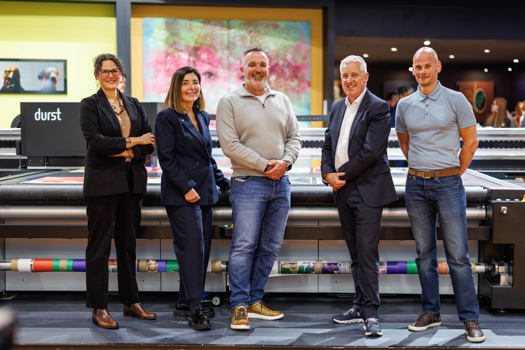KAS’s new entry-level folder-inserter, the Mailmaster Compact C4, is intended for users with mailing runs in the thousands rather than tens of thousands, which is exactly what Hampstead calls the “zone of confusion”. So KAS has made its baby folder-inserter easy to set up and change over between sizes, “so that if customers find it’s more economical for them to run a mailing, or part of a mailing, as a C5 envelope rather than C4, say, they can change their minds at the very last minute,” says Hampstead.
Stepping stone
With the Compact C4, KAS is also aiming to plug a gap in its range. Existing folder-inserters – the Mailmaster 464HS and 465HS – are enormously flexible in terms of speed, number of feeders (hence number of items that can be mailed in a pack), and their ability to address and sort; and for this level of flexibility naturally there’s a price-tag. The Compact aims to offer customers a step between hand-filling or a desktop folder-inserter and the 464/465HS machines, without demanding such a high level of either capital outlay or throughput to justify that capital outlay.
The chassis and architecture of the Compact C4 are based on its bigger siblings, while the feeder is a cut-down version of the 465HS’s feeder. The Compact comes as standard with three feeders, two of which will feed any item from a single 80gsm sheet up to a 7mm book, and the third of which incorporates a folder which can be used to fold single sheets once or twice before adding to the accumulating pile on the transport chain. A fourth feeder can optionally be added, again with or without a folder.
The feeders are a roll-feed design. A set of rollers underneath the bottom sheet in the pile pushes the sheet out of the feeder and into a second set of rollers that pulls the item away from the pile altogether and pushes it onto the accumulator track. With a top-load, bottom-feed design, it’s possible to run the Compact without stopping to load.
After the collated set has accumulated, the track takes the set towards a set of inserting “shoes” – two U-shaped pieces of stainless steel that channel the set into the envelope smoothly. An envelope feeds onto the track and the shoes slide into the envelope to hold it open – the accumulated set slides through the shoes and into the envelope. The filled envelope is taken away on the track and its flap is moistened with a spray brush, after which the flap is folded over, sealed with a set of presser rollers, and ejected onto the delivery conveyor, where it’s stacked. (Note that the Compact can only take gummed envelopes – there is no facility to handle remoistenable glues.)
The Compact can be hooked up to upstream machines – for example, at GraphExpo earlier this month, KAS showed it linked to a Horizon vertical collator. “There’s no reason why we couldn’t take output directly from any collator or even a digital press if the customer wanted that as an application,” says Hampstead. And unusually for an entry-level machine, the Compact can also be controlled by a reader – for instance, sheets or items printed with a barcode, or with OMR or OCR characters, can be matched with other sheets or items similarly marked to make up a personalised set that can be matched to an envelope. This facility can also be used to control the feeders, meaning that selective mailings can be run.
Touchscreen control
Via its operating touchscreen, the Compact C4 can be set to a preset count that will leave a space between each user-definable batch. Alternatively, batches can be defined via any attached reading system – if the Compact is configured with a set of barcode readers, the readers can signal to the line where to end a batch. This is useful for sorting in postcode order, for instance. The touchscreen is also the place where operators can set envelope marking, and pack diversion: “If, say, you were mailing a card statement, and a customer had a zero balance so didn’t need a statement, you can divert their statement out of the mail flow,” Hampstead explains. The touchscreen also flags up errors and jams, displaying the region of the Compact in which they have occurred.
Making the Compact C4 ready is an easy process. The operator switches on the power, loads the feeders with the relevant documents or items, and loads the envelope feeder with the appropriate size of envelope. After that, a set of hand-dials are adjusted to set the thickness for each item –and the double detector that sits on each feeder – and the Compact is ready to run. There’s no facility for job memory storage, because all the adjustable parameters are mechanically set, but as Hampstead says, when set up only takes four minutes, there’s no point in spending a disproportionate amount of money on automation.
The maximum size that the Compact can mail is determined by the envelope – and the Compact will take an oversize C4, which allows it to accommodate a content thickness of up to 15mm (an ordinary C4 envelope will take around 12mm). Addresses are typically printed as part of the document, and the Compact uses window envelopes to make the address visible, but it’s also possible to put an inkjet addressing system, driven by a customer database, onto the delivery station. But Stephen Hampstead says that on an entry-level machine like the Compact this is “a somewhat disproportionately expensive solution”.
The Compact C4 was launched at Ipex in April, and KAS has three already installed in the UK – at a local council, a building society and a small mailing house. The local council – Kirklees in West Yorkshire – bought the Compact because it had been outsourcing its mailing and wasn’t happy with the matching integrity between content and addressee. Now, as well as doing its own mailings, it’s offering short-run mailing to other local government departments on a fee-paying basis. The mailing house, which already has a Mailmaster 465HS, needed a second-string machine that took up minimal floor-space. The building society again had a 465HS but needed a Compact to add capacity. “This is where we’re aiming with the Compact,” Hampstead says. “Users who can’t afford, can’t utilise, don’t want, a full-on 465HS, but have
too much work for hand-mailing.”
SPECIFICATIONS
Max size of sheet or item 210x297mm
Stock range (each individual item)80gsm to 7mm
Max speed 5,000 filled envelopes per hour
Price £38,000 (three feeders)
Contact KAS Paper Systems 01582 662211 www.kas.uk.com
THE ALTERNATIVES
Mailing Solutions FPi5000
Mailing Solutions’ modular folder-inserter is a versatile free-standing machine that can be configured with two, four or six document feeders. Feeders are continuous and there’s a “swap” mode that switches feed to a full hopper while an empty one is filled.
Max size of sheet or item 238x356mm
Stock thickness range 80gsm – 2mm
Max speed 3,500 filled envelopes per hour
Price £11,000 (two feeders)
Contact Mailing Solutions UK 08453 311007 www.mailingsolutionsuk.co.uk
Neopost SI-82
This floor-standing folder-inserter is a bit slower than the KAS Compact, but more automated, with a touchscreen job memory bank. Up to seven feed stations and an OMR option to control selection of items, folding and inserting.
Max size of sheet or item 230x356mm
Stock thickness range 70gsm–2.5mm
Max speed 4,300 filled envelopes per hour
Price £19,000 (two feeders) to £30,000 (seven feeders)
Contact Neopost 0800 515297 www.neopost.co.uk
Pitney Bowes FastPac DI3500
The DI3500 incorporates two inserting systems (DL-C5 and C4). Set-up is automatic from a touchscreen. Up to four feeders can run continuously with no stops for loading. Option for a post-job verification and integrity check.
Max size of sheet or item 420x305mm
Stock thickness range 70gsm–8mm
Max speed 7,000 filled envelopes per hour
Price from £50,000
Contact Pitney Bowes 08705 252525 www.pitneybowes.co.uk








